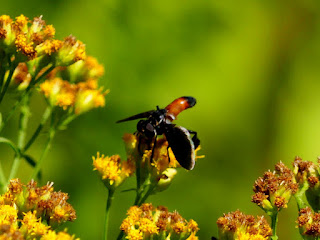We're the Flies
Yesterday's post was about insects that are not flies but have "fly" in their names, potentially confusing their place in taxonomy. Today I'm going to show some of the true flies (order Diptera) out there.
Note that I encounter lots of members of the true flies of which I don't have pictures. Gnats are awfully small and frequently in flight. And when I'm meeting mosquitoes and deer flies, I'm usually trying to swat them before getting bitten rather than trying to photograph them. Finally, I've just had trouble confirming IDs for many crane flies.
Having said that, hopefully this will give you some sense of the diversity of this group of insects. Let's start with bristle flies (aka Tachinid flies), though the first doesn't look as bristly as the second. As larva, these flies generally grow by slowly eating another insect species; as adults many are pollinators. Sometimes they're considered beneficial because they help control destructive invasive species like Gypsy Moths or Japanese Beetles, but other species use Monarch butterflies as their hosts.
 |
| Swift Feather-legged Fly September 6, 2020 at Scherman Hoffman Wildlife Sanctuary Photo 94484872, (c) jpviolette, some rights reserved (CC BY-NC) |
 |
| Juriniopsis adusta September 8, 2019 at Duke Farms Photo 52120163, (c) jpviolette, some rights reserved (CC BY-NC) |
I recently discussed flower flies (aka hoverflies aka syrphid flies) when discussing the Eastern Calligrapher, but there are lots of other flies in this group. As kids (larva) they will eat dead animal/plant matter or little arthropods like aphids, but as adults they mostly function as nectar-drinking pollinators.
 |
| Black-shouldered Drone Fly October 7, 2019 at Duke Farms Photo 53696510, (c) jpviolette, some rights reserved (CC BY-NC) |
 |
| Transverse-banded Flower Fly October 8, 2019 at Duke Farms Photo 55275631, (c) jpviolette, some rights reserved (CC BY-NC) |
After the pollinating flies, let's look at some of the ferocious predators of the insect world, the robber flies (aka Asilid flies). Ones like the cannibalflies are known for killing/eating even other predatory insects like dragonflies/damselflies, though they won't hesitate to kill pacifist insects either. Another in my area is a bee mimic, which both helps it get close to its bee prey and helps ward off any predator that fears getting stung.
 |
| Red-footed Cannibalfly July 28, 2021 at Sourland Mountain Preserve Photo 148654834, (c) jpviolette, some rights reserved (CC BY-NC) |
 |
| Bumblebee Mimic Robber Fly May 20, 2021 at Round Valley Reservoir Photo 132040260, (c) jpviolette, some rights reserved (CC BY-NC) |
Next is a group that includes insects that bite us, the horse/deer flies (aka Tabinid flies). They're predatory both as larva (aquatic) and adults (warm blooded animals like us). The Black Horsefly pictured doesn't usually bother humans; I'm not sure why.
 |
| Black Horsefly August 20, 2021 at Sourland Mountain Preserve Photo 91648976, (c) jpviolette, some rights reserved (CC BY-NC) |
Let's end with the blow flies (aka Calliphorid flies). These flies drink nectar as adults, but grow up eating carrion or dung as larva. You may spot females laying eggs on such food sources.
 |
| Greenbottle Fly June 28, 2019 at Negri-Nepote Native Grassland Preserve Photo 43667657, (c) jpviolette, some rights reserved (CC BY-NC) |



Comments
Post a Comment